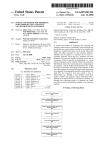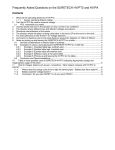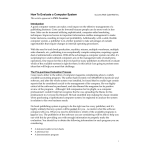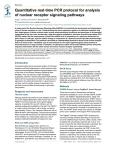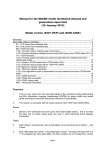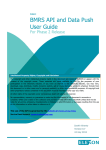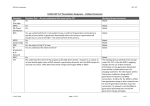Download CDCM User Manual – February 2013
Transcript
CDCM model user manual Model Version: 102 28 February 2013 energynetworks.org 28/02/201328/02/2013Page 1 of 41Page 1 of 41 Contents Overview .............................................................................................................................. 4 Updating the CDCM model ................................................................................................. 8 Frequency of Update............................................................................................................. 8 Distribution time bands .................................................................................................... 10 Guidance on asset models ............................................................................................... 11 General costing guidance for asset models......................................................................... 11 Network model .................................................................................................................... 11 Service models ................................................................................................................... 13 Input data tables ............................................................................................................... 17 1000. Company, charging year, data version ..................................................................... 17 1001. CDCM Target Revenue Calculations......................................................................... 17 1010. Financial and general assumptions .......................................................................... 17 1017. Diversity allowance between top and bottom of network level .................................. 18 1018. Proportion of relevant load going through 132kV/HV direct transformation ............... 18 1019. Network model GSP peak demand (MW) ................................................................. 18 1020. Gross asset cost by network level (£) ....................................................................... 19 1022. LV service model asset cost (£) ............................................................................... 19 1023. HV service model asset cost (£) ............................................................................... 19 1025. Matrix of applicability of LV service models to tariffs with fixed charges.................... 19 1026. Matrix of applicability of LV service models to unmetered tariffs ............................... 19 1028. Matrix of applicability of HV service models to tariffs with fixed charges ................... 19 1032. Loss adjustment factors to transmission ................................................................... 19 1037. Embedded network (LDNO) discounts ..................................................................... 19 1041. Load profile data for demand users .......................................................................... 20 1053. Volume forecasts for the charging year .................................................................... 22 1055. Transmission exit charges (£/year)........................................................................... 23 1059. Other expenditure .................................................................................................... 23 1060. Customer contributions under current connection charging policy ............................ 24 1061 and 1062. Average split of units by distribution time band ......................................... 25 1064. Average split of rate 1 units by special distribution time band .................................... 25 1066. Typical annual hours by special distribution time band ............................................. 25 1068. Typical annual hours by distribution time band ......................................................... 25 1069. Peaking probabilities by network level ...................................................................... 25 1092. Average kVAr by kVA, by network level.................................................................... 26 1201. Current tariff information ........................................................................................... 26 Calculation sheets ............................................................................................................ 28 LAFs — Loss adjustment factors and network use matrices ............................................... 28 DRM — Network model ...................................................................................................... 29 SM — Service models......................................................................................................... 29 Loads — Load characteristics ............................................................................................. 30 Multi — Load characteristics for multiple unit rates ............................................................. 30 SMD — Forecast simultaneous maximum load ................................................................... 33 AMD — Forecast aggregate maximum load ........................................................................ 33 Otex — Other expenditure .................................................................................................. 35 Contrib — Customer contributions ...................................................................................... 36 Yard — Yardsticks .............................................................................................................. 37 Standing — Allocation to standing charges ......................................................................... 37 NHH — Standing charges as fixed charges ........................................................................ 38 Reactive — Reactive power unit charges ............................................................................ 38 Aggreg — Aggregation........................................................................................................ 39 Page 2 of 41 Revenue — Revenue shortfall or surplus ............................................................................ 40 Scaler — Revenue matching............................................................................................... 40 Adjust — Tariff component adjustment and rounding .......................................................... 41 Page 3 of 41 Overview 1. This user manual accompanies the spreadsheet model that is used to implement the Common Distribution Charging Methodology (CDCM) for electricity distribution networks in Great Britain (the CDCM Model). The CDCM is contained within Schedule 16 of DCUSA and the current model version number is referred to in paragraph 3 of Schedule 16. 2. This user manual is based on version 102 of the model which is effective from 1st April 2013. This version incorporates the following change proposals that have been implemented since the user manual was last released: (a) Change Proposal 130 – To replace the non-half hourly unmetered supplies tariff with four new non-half hourly unmetered supplies tariffs (dusk to dawn, dawn to dusk, part night and continuous) (b) Change Proposal 132 – To provide a breakdown of the Allowed Revenue used within the CDCM model 3. The CDCM model may be updated following a DCUSA change proposal. Users of the CDCM Model should check that they are using the most up to date version of the model by checking the current version of DCUSA at the DCUSA website: http://www.dcusa.co.uk/Public/DCUSADocuments.aspx?s=c. 4. The CDCM model is owned by DCUSA and any changes to the model will be approved by the DCUSA panel before they release the model for general use. DCUSA has a change process in place before any amendment to the CDCM model or the methodology can take place. This requires a change proposal to be raised by an interested party and acceptance of the change by the Authority. 5. Figure 1, reproduced from the CDCM statement, shows the main steps in the methodology and model. Figure 2 gives an overview of relationships between the main elements of the model. Page 4 of 41 Figure 1 Overview of main steps and data flows Figure 2 Overview of the relationship between elements of the model Sheets 6. Sheets in the workbook have been given very short abbreviated names. This is to make the best use of screen space given the way in which Microsoft Excel displays information. A proper title appears at the top of each sheet. 7. Figures 3 and 4 are maps of the calculation sheets in the model workbook. Page 5 of 41 Figure 3 Step 2 sheets in the workbook (data flow from left to right) Figure 4 Step 3 sheets in the workbook (data flow from left to right) Tables 8. Each sheet is structured as a list of data tables, to be read from top to bottom — like a book. 9. Each of these data tables has a four-digit table number. Numbers that start with 10 are manually assigned for input data tables and do not change from version to version. Other table numbers are assigned when the model is built and may vary when the model is changed or different options are selected. Hyperlinks in the workbook 10. The tables in the model are listed in the overview sheet, with hyperlinks to the data. Links to the source data for each calculation are shown above each calculation table. 11. The Back button in Microsoft Excel can be useful when navigating around the workbook using these hyperlinks. To go back to where you were before clicking a hyperlink, use the Back button. 12. The availability and location of the Back button depends on the version of Microsoft Excel. It might be an optional element of the ribbon, or it might be located on the Web toolbar (available from the View menu), or it might be an optional feature that can be added to the Quick Access Toolbar. 13. Links do not work well if the model is displayed within a web browser. To get the full functionality, save the model as a file and open it in Microsoft Excel or compatible software. Page 6 of 41 Technologies and dependencies 14. The model is implemented as a stand-alone Microsoft Excel workbook in either Excel 1997–2004 or Excel 2007–2011 file format. No software other than a relevant version of Microsoft Excel or compatible software is needed to operate the model. 15. The model relies on standard spreadsheet formulae. It does not use any macros, Visual Basic for Application, pivot tables, solver, goal seek, or array formulae. 16. The workbook is produced by a computer programme in the programming language Perl 5. This programme can be run on a personal computer or as a web service, and can generate versions of the models with different tariffs or allocation rules. Overview sheet 17. The overview sheet (Overview) lists the data tables in the workbook. Input sheet 18. The input data sheet (Input) contains all the input data for the model. Tariff sheets 19. The tariff sheet (Tariffs) summarises the final tariffs. Additional output sheets 20. The summary sheet (Summary) gives a copy of the tariffs, average revenue per unit and average revenue per user for each tariff, and a summary of options and assumptions used in the model. 21. Tariff matrices are provided on the M-ATW sheet. Tariff matrices show the tariff components of the final tariffs and their decomposition into the various elements of cost and revenue in a form that can be easily read and printed. 22. The revenue matrix sheet (M-Rev) shows the revenues raised in respect of each end user type and each element of cost or revenue in the model. 23. The comparison sheets (CData and CTables) attempt an indicative comparison between current and proposed all-the-way tariffs, and between all-the-way and LDNO tariffs. 24. All these additional output sheets are for information only. They can be removed or modified without effect on the rest of the calculations. Page 7 of 41 Updating the CDCM model Frequency of Update 25. DNOs can modify charges to customers at any time, but Section 19.1 of DCUSA stipulates that DNOs should use reasonable endeavours to modify charges no more than twice a year and to use reasonable endeavours to vary charges from the effective date of 1st April or the 1st October. The issue of charges follows a timetable which is set down in SLC 14.11. Under this licence condition, DNOs are required to give 3 months notice for indicative charges and, under section 19.1 of DCUSA, 40 days notice for final charges. The charges can only change between indicative and finals to the extent that the DNO identifies they contain assumptions when they issue indicatives that may change prior to the issue of the final charges. 26. The review and issue of the CDCM model will follow the timetable outlined above. All of the inputs into the CDCM model will be reviewed once a year prior to the issue of charges for the 1st April. 27. For a mid-year tariff change, DNOs are able to review and modify any of the CDCM inputs. However, as a general guideline, the table below shows which inputs would typically be modified as part of a mid-year tariff review:: CDCM Input data table: 1000. Company, charging year, data version 1001. Target revenue 1010. Financial and general assumptions 1017. Diversity allowance between top and bottom of network level 1018. Proportion of relevant load going through 132kV/HV direct transformation 1019. Network model GSP peak demand (MW) 1020. Gross asset cost by network level (£) 1022. LV service model asset cost (£) 1023. HV service model asset cost (£) 1025. Matrix of applicability of LV service models to tariffs with fixed charges 1026. Matrix of applicability of LV service models to unmetered tariffs 1028. Matrix of applicability of HV service models to tariffs with fixed charges 1032. Loss adjustment factors to transmission 1037. Embedded network (LDNO) discounts 1041. Load profile data for demand users 1053. Volume forecasts for the charging year 1055. Transmission exit charges (£/year) 1059. Other expenditure 1060. Customer contributions under current connection charging policy 1061. Average split of rate 1 units by distribution time band 1062. Average split of rate 2 units by distribution time band 1064. Average split of rate 1 units by special distribution time band 1066. Typical annual hours by special distribution time band 1068. Typical annual hours by distribution time band 1069. Peaking probabilities by network level 1092. Average kVAr by kVA, by network level 1201. Current tariff information Page 8 of 41 Reviewed for 1st April Tariff Change √ √ √ √ Reviewed for Mid Year Tariff Change √ √ √ √ √ √ √ √ √ √ √ √ √ √ √ √ √ √ √ √ √ √ √ √ √ √ √ √ √ √ Annual Review Pack 28. DNOs will issue the Annual Review Pack (ARP) on or before the 31st December each year based on the CDCM model used to derive indicative charges. If the CDCM model is amended between indicatives and finals, the ARP will also be updated and published 40 days prior to when the charges take effect. The ARP is only published once a year for charges that apply from 1st April. DNOs are not obliged to produce an ARP if charges are amended at other times of the year. 29. The ARP is a Excel spreadsheet that contains the following: (a) A 5 year forecast of the CDCM inputs which are used to derive tariffs. The first year will be the actual values used by the DNO to derive indicative or final charges from the following April. The subsequent years will be a forecast of the CDCM inputs by the DNO. The ARP contains CDCM input sheets for each year that match the CDCM input sheet and can be directly copied into the CDCM model. (b) Historical CDCM input data for a minimum period of three years. (c) The ARP contains a macro that can be run to produce tariffs and typical bills for each of the 5 years. This data is provided to assist customers, suppliers and any other stakeholders in forecasting longer term Distribution Use of System Charges for HV and LV customers. (d) Within the ARP, the DNO provides a RPI forecast which will be linked to any of the CDCM inputs which the DNO believes are related to RPI. This is to enable users of the annual review pack to update the RPI forecast and for it to automatically update the appropriate CDCM input. (e) A commentary on the forecast and justification of the forecast for each CDCM input via individual comments. (f) The timebands that will be used in each of the 5 years contained within the annual review. The forecast CDCM input data will be provided by DNOs based on their own perception of how the CDCM input data may change over the 5 year period. The format of the annual report will be common, but the actual forecast will be DNO specific to allow DNOs flexibility to express their views and provide a realistic forecast. Page 9 of 41 Distribution time bands 30. In order to use the CDCM model, each DNO must determine five distribution time bands, labelled amber, black, green, red and yellow. These time bands are expected to have the following properties: (a) Red, amber and green must not overlap and between them must cover all time periods in the year. The model refers to this set of time band as the distribution time bands. (b) Black, yellow and green must not overlap and between them must cover all time periods. The model refers to this set of time band as the special distribution time bands. (c) Black should be a subset of red. (d) Red, amber and green should be defined solely by reference to UK clock time and weekday/weekend classification, where weekend means Saturday or Sunday. In particular, they should not depend on any public holidays, months or seasons, 31. In some cases, for example in the published tariffs or in the volume forecast, time band data might be labelled by unit rate numbers rather than by colour. The mapping is as follows: (a) Rate 1 might refer to the black time band, the red time band, or a day period unrelated to any coloured time band. (b) Rate 2 might refer to the amber time band, the yellow time band, or a night period unrelated to any coloured time band. (c) Rate 3 refers to the green time band. Page 10 of 41 Guidance on asset models 32. Two types of asset models are used: (a) The network model (also known as DRM or 500 MW model) relates to shared or shareable assets in the network. (b) The service models relate to assets dedicated to a single network user. 33. This section provides guidance on the development of these assets models. General costing guidance for asset models 34. The unit costs in the model should reflect what it would cost to purchase and install the assets included in the hypothetical incremental network, including building and civil engineering works, in unmade ground. 35. In the case of LV underground cables, one third of excavation costs should be included in unit costs. (This factor comes from an assumption that these costs are shared with gas and water utilities.) No reinstatement costs should be included. 36. Overheads directly related to the construction activity should be included. 37. Land or easement purchase values should not be included. The costs of applying for planning permission or taking part in a public inquiry should not be included. Wayleave rental payments should not be included. Legal and administrative costs incurred in establishing wayleaves should be included. 38. Unit costs for actual or planned asset replacement projects (including any unit costs included in business plan submissions to Ofgem) should be disregarded in pricing the network model if relying on them would conflict with the assumptions above. Network model 39. The assets in each network level of the model should be sized to be sufficient to supply loads which are representative of the mix of demand for the licensee’s area and which, once aggregated and measured at the grid supply point level, have a peak demand of 500 MW. 40. By exception to the rule above, if a 132kV/HV network level is used, then the 132kV/HV network level should be sized to meet loads which, aggregated and measured at the grid supply point level, would make a contribution to peak demand equal to 500 MW times the 132kV/HV proportion. In that case, the 132kV/EHV, EHV and EHV/HV network levels should be sized to loads which, aggregated and measured at the grid supply point level, would make a contribution to peak demand equal to 500 MW times one minus the 132kV/HV proportion. 41. No generation should be assumed in the network model’s customer mix. 42. The hypothetical 500 MW network for each network level must be designed as an increment serving loads that have the same topography, diversity and other characteristics as the actual loads on the existing network. In particular, customers’ locations and consumption patterns should be representative of reality in the licensee’s area. But the hypothetical network used to supply them must reflect current design practice and the assumptions about utilisation detailed below for a forward-looking hypothetical incremental network: the mix of assets in this hypothetical network need not be similar to that in the licensee’s network. Page 11 of 41 43. The volume and capacity of assets included in the model at each network level should be based on the minimum-cost way of delivering the minimum amount of redundancy required to comply with Engineering Recommendation P2/6. The design must be feasible; asset quantities should be rounded up to accommodate at least the required capacity without using notional fractions of assets. The licensee’s own planning guidelines must be ignored insofar as they impose greater security, redundancy or resilience requirements than Engineering Recommendation P2/6. 44. The design of the hypothetical incremental network must not rely on any spare capacity that might exist on current network assets. 45. The hypothetical incremental network must not include any spare capacity to cater for any further growth, even if it would be normal practice of the company to plan for such growth when establishing new networks. Because of this assumption, the utilisation factors in the hypothetical incremental network may be higher than actual utilisation factors in the network. Actual utilisation factors in the network should not be relied upon as the basis for assumptions in the model, although they may be used as a cross-check for the assumptions made. 46. The possibility of using emergency ratings in fault or outage situations should be taken into account in estimating the asset volumes and capacities required in the hypothetical incremental network. 47. For example, a substation with two transformers rated 12/24 MVA (i.e. 12 MVA with passive cooling and 24 MVA with active cooling) is sufficient to meet a maximum load of 24 MVA, since that level of load could be accommodated on a single transformer if the other was out of use (n–1 situation). 48. Similarly, a substation with two transformers rated 90 MVA, who are each considered capable of accommodating an emergency flow of 117 MVA if necessary (30 per cent more than the continuous rating of 90 MVA), is sufficient to meet 117 MVA. 49. In a situation where interconnection is used to provide security, then a more detailed analysis of redundancy requirements should be used. For example, three 132kV/33kV single-transformer 60 MVA with 30 per cent emergency rating substations supplying a 33kV interconnected ring would be considered able to supply an aggregate load of 156 MVA (calculated as twice the emergency flow of 78 MVA). 50. At EHV (including primary substations), no additional capacity should be included in the hypothetical incremental network on account of geographical dispersion of loads; a sufficient range of substation sizes should be included in the model to ensure that this is a reasonable assumption. 51. At HV and LV, the estimated utilisation in the hypothetical incremental network should take account of geographical dispersion of loads and the use of standard-size equipment. A sample of maximum loads from substations on the network may be used to estimate utilisation (as the aggregate maximum load divided by the aggregate of the smallest standard substation size that will accommodate each load in the sample). 52. In the absence of other information, utilisation rates of assets in the network or assumed utilisation rates in recent extensions to the network may be used to inform the assumptions made. Such evidence must not be used if doing so would conflict with the requirement not to include additional capacity to cater for future growth. 53. Circuit lengths in the hypothetical incremental network depend on the geographical distribution of loads and on the geographical distribution of substations. Data on Page 12 of 41 circuit lengths from the actual network may be used to inform these assumptions, provided that appropriate adjustments are made for any differences in the type of substations in the hypothetical incremental network compared to the actual network. Circuit sizes must be taken to be the lowest relevant standard size that will deliver the required capacity. Service models 54. The assets included in service models are the assets that would be constructed under the licensee’s current engineering practices to establish a connection with a customer, excluding assets that are included in the 500 MW network model. 55. Shared, shareable or potentially shareable assets should be included in the network model. Only sole-use assets that are not shareable or potentially shareable are therefore permitted in service models. 56. Different customers might require different service assets. Averaging is required to produce generic figures for use in setting use of system tariffs. 57. The remainder of this section outlines the service model for each tariff. HV Medium Non-Domestic 58. This is a non-half-hourly metered customer, i.e. less than 100 kW. This will typically be a legacy site in a remote area, a site which is no longer operating at the capacity for which it was designed, or a generator’s own demand. 59. In order to avoid undue discrimination between generators on the basis of whether their station demand is half hourly settled or not, this should use the same service models as for the HV HH Metered tariff. HV HH Metered 60. The cost should cover the ring main unit (including installation and jointing) but none of the HV feeder, cable or line costs — all of the HV lines are treated as part of the HV network and not as service model assets. 61. Different companies may use different grades of ring-main units for their typical HV customers (e.g. fuse-based v circuit breakers), so there may be large but legitimate differences in cost between companies. HV Sub HH Metered 62. The cost should cover the installation and jointing of a suitable circuit breaker within the primary substation, excluding any costs of expanding the primary substation building. No EHV or transformation costs should be included. 63. Only short lengths of cable within the substation can be included — any HV line going outside the boundary of the substation is a potentially shareable asset and is treated as part of the HV network — therefore not as a service model asset. 64. The above reflects the rule that a customer connected to a primary substation through a HV cable owned by the DNO that goes beyond the boundary of the primary substation is a HV network customer, not a HV substation customer. Page 13 of 41 HV Generation Intermittent / HV Generation Non-Intermittent 65. These service models should reflect the additional cost of protection equipment for a typical generator in each category, for example the difference in cost between a fuse and a circuit breaker, or the costs of additional telecommunications equipment that would be generally required for an HV generation connection. Domestic Unrestricted 66. The supply is a single-phase LV supply to a domestic customer. 67. The model is priced on the hypothetical basis that services are being built or re-built for a whole street as a single planned project — not an ad hoc replacement for one isolated user. 68. The cost of creating a joint between the LV mains and the LV service cable is included in the service model, as are all costs associated with service cables and with any distribution boards. No costs associated with the LV mains are included in the service model. 69. Because of the requirement to cost the service model on the basis of a single planned project, the model will normally include several connections. The number of connections in the model is reflected through table 1025 “matrix of applicability”. The percentage figure in that table is the proportion of the cost of the service model that is attributable to each customer. For example, if the model is for a scheme to connect 20 houses, then the percentage is 5 per cent. 70. Table 1025 also allows several service models to be averaged. For example, if 10 per cent of houses are in rural areas where the typical set-up is a pole serving five houses, and 90 per cent of houses are in urban areas where the typical set-up is a length of mains serving 20 houses, then the service model costs should be entered as the cost of the five-house rural scheme and the cost of the 20-house urban scheme, and table 1025 should have, in the domestic unrestricted row, 2% (=10%/5) against the rural scheme and 4.5% (=90%/20) against the urban scheme. Domestic Two Rate 71. The supply should reflect the way in which Domestic Two Rate customers are supplied in the relevant GSP Group. This will usually be the same as for Domestic Unrestricted, although in some areas it might include three-phase supplies instead of single-phase supplies. 72. The other guidance under Domestic Unrestricted applies to Domestic Two Rate. Domestic Off Peak (related MPAN) 73. No service model data should be entered for the Domestic Off Peak (related MPAN) tariff if the same service cable would be used irrespective of whether there is a related MPAN or not. 74. If, in a particular GSP Group, there is a strong association between having a threephase supply and having a related MPAN, then it might be appropriate to treat the additional cost of a three-phase supply over a single-phase supply as a service model for the Domestic Off Peak (related MPAN) tariff. Page 14 of 41 Small Non Domestic Unrestricted 75. This service model relates to the building a new typical supply for a profile class 3 customer. 76. Only cables on or very near the customer’s land should be included in the service model. Longer cables installed to connect to existing mains are potentially shareable. Small Non Domestic Two Rate 77. This service model relates to the building a new typical supply for a profile class 4 customer. This will often be the same as for Small Non Domestic Unrestricted. Small Non Domestic Off Peak (related MPAN) 78. The guidance given under Domestic Off Peak (related MPAN) applies to service models for this tariff. LV Medium Non-Domestic 79. This service model relates to the building of a new typical supply for a profile class 5– 8 customer. 80. As the customer will be non half hourly metered, the capacity of the connection need not exceed 100 kW. 81. Provision for current transformers used for metering purposes should be included in the service model. No metering costs should be included — these relate to the metering activity and not the distribution activity. 82. Only cables on or very near the customer’s land should be included in the service model. Longer cables installed to connect to an existing mains are potentially shareable and therefore part of the network model. LV Sub Medium Non-Domestic 83. The typical customer for this tariff (which must be under 100 kW as it is non half hourly metered) is a legacy site in a remote area or a site which is no longer operating at the capacity for which it was designed. 84. The guidance under LV Sub HH Metered applies to this service model. LV HH Metered 85. This service model relates to the building of a new typical supply for half hourly metered customer, typically over 100 kW. 86. Provision for current transformers used for metering purposes should be included in the service model. No metering costs should be included — these relate to the metering activity and not the distribution activity. 87. Only cables on or very near the customer’s land should be included in the service model. Longer cables installed to connect to an existing mains are potentially shareable and therefore part of the network model. Page 15 of 41 LV Sub HH Metered 88. This service model relates to the building of a new typical supply for a customer with a dedicated substation, not including any HV/LV transformation costs or any HV costs. (A charge for the average cost of HV/LV transformation will be made through the 500 MW model, so that including the transformer in the service model would amount to double-counting.) 89. If the metering breaker is typically separate from the substation, then the costs are for that breaker and the short cable between that breaker and the substation, plus jointing. 90. It would not be surprising for the cost to be less than for LV HH Metered, even though the capacity will be higher. 91. The above reflects the rule that a customer connected to a substation (whether dedicated or shared) through a LV cable owned by the DNO that goes beyond the boundary of the HV/LV substation is a LV network customer, not a LV substation customer. LV Generation (NHH / Intermittent / Non-Intermittent) 92. These service models should reflect the additional cost of protection equipment for a typical generator in each category, for example the difference in cost between a fuse and a circuit breaker. 93. There is almost certainly no service model for LV Generation NHH: such small generating units would not be expected to require special protection. Unmetered supplies 94. For unmetered supply tariffs, the service model cost is expressed as a cost (£) for each estimated MWh of electricity distributed in a year. To make that estimate, the DNO Party defines one or more typical or average configurations of unmetered supplies, and estimates for each configuration the service model cost and the number of units expected to be delivered through that hypothetical system in each year, taking account of typical or average consumption rates and operating hours of items supplied under unmetered supply tariffs. A single estimate is used for all unmetered supply tariffs. 95. The percentages in the matrix of applicability are based on 1 MWh/year. For example, if the scheme connects columns with, in total, 10 lamps of 70 W each, burning for an average of 12 hours a day, then the total annual consumption of the scheme is 10*70W*12h*365 = 3.07 MWh, and the figure in the relevant cell of table 1026 is 33%. Page 16 of 41 Input data tables 96. This section reviews each of the tables in the input data sheet, providing guidance on data definitions and possible data sources wherever possible. Table 1001 is contained in the “CDCM Revenues” sheet and the remaining input tables are all contained within the “Input” sheet of the model. 1000. Company, charging year, data version 97. The text entered in table 1000 will be reproduced at the top of each sheet. It does not affect any calculations. 1001. CDCM Target Revenue Calculations 98. This table provides the amount of revenue to be recovered from CDCM charges net of CDCM credits. The table is structured in the same format as the DCUSA cost data that is submitted every quarter by DNOs. 99. The data is entered in pounds and the target revenue is contained within the bottom row. 100. To run the CDCM model for a mid-year price change, the target revenue needs to be adjusted so that the correct revenue is recovered over the year as a whole. This may be achieved by using one of the models produced in the development work for DCP088, or through an iterative method or goal seek technique. In some cases, the method suggested in some previous versions of this user manual might provide an acceptable starting point for an iterative technique, but it must not be relied upon without checking. 1010. Financial and general assumptions 101. This table contains the following assumptions: (a) The rate of return to be used to calculate annuity factors. This is the (pre-tax) cost of capital set by the Authority as part of the then most recent review of the charge restriction conditions applying under the DNO Party’s Distribution Licence (b) The annualisation period to be used to calculate annuity factors. (c) The proportion of the full annuity that should be included in prices in respect of assets which are deemed to be covered by customer contributions. (d) The power factor assumed in the network model. (e) The number of days in the charging year. 102. The first four parameters are specified on the face of the methodology statement. 103. The CDCM model has been set up to run for a one year period. To run the CDCM model for a mid-year price change, the number of days in the charging year should be left at 365 or 366 as appropriate, and the following procedure used: (a) Estimate net CDCM revenue forecast to accrue within the first half and within the second half of the year, if current tariffs were continued. Denote these forecasts R1 and R2. Unless volume forecasts have changed since tariffs were set, R1 + R2 will be equal to the net CDCM target revenue used to set tariffs. Page 17 of 41 (b) Produce an updated estimate of net CDCM revenue (including K factor, net of revenue outside the model, etc) for the whole year. Denote this NTR. (c) Populate the CDCM model with latest data for all inputs and with the following CDCM target revenue figure: (NTR – R1)/R2*(R1 + R2). The result of that calculation should be entered in the first column of table 1076 and all other columns in table 1076 should be set to zero for this purpose. 1017. Diversity allowance between top and bottom of network level 104. Up to four figures are to be entered in this table. They are in the rows labelled “GSP”, “132kV”, “EHV” and “HV”. The other cells in this table should be left blank or so to zero. In Scotland, the “132kV” figure should also be left blank or set to zero. 105. Each figure is a diversity allowance expressed as a percentage. It represents the extent to which aggregate maximum load across a set of substation sites exceeds the maximum of the total flow through these sites. 106. These diversity allowances are expressed as percentages, relative to a value of zero to indicate no diversity. The diversity allowance is the extent to which some aggregate maximum load exceeds the corresponding maximum of the aggregate load. 107. The figure in the “GSP” row relates to diversity between the GSP Group and individual grid supply points. 108. The figure in the “132kV” row (in England and Wales only) relates to diversity between a grid supply point and the 132kV/EHV bulk supply points under it. It is labelled “132kV” because it is the diversity between the top and the bottom of the 132kV network. 109. The figure in the “EHV” row relates to diversity between a 132kV/EHV bulk supply point (or grid supply point in Scotland) and the EHV/HV primary substations under it. 110. The figure in the “HV” row relates to diversity between a EHV/HV primary substation and the HV/LV substations under it. 111. These diversity allowances should be entered in a non-cumulative basis. The model cumulates them as necessary (see the DRM sheet). 112. Insofar as the network topology and substation mix of the 500 MW model differs from the network topology and substation mix of the actual network, diversity allowances relate to the 500 MW model. 1018. Proportion of relevant load going through 132kV/HV direct transformation 113. The single cell in this table contains the percentage of the loads at HV, LV Sub or LV load which is supplied through direct 132kV/HV transformation. Leaving this cell blank signifies that 132kV/HV is not used in the 500 MW model. 1019. Network model GSP peak demand (MW) 114. The single cell in this table should be set to the figure of 500, corresponding to the 500 MW specified in the methodology statement. Page 18 of 41 1020. Gross asset cost by network level (£) 115. The figure to be entered in each cell is the aggregate cost of the assets at that level in the 500 MW network model, in £. 116. See the asset models guidance above (page 9) for more information. 1022. LV service model asset cost (£) 117. This table gives asset costs for each LV service model. 1023. HV service model asset cost (£) 118. This table gives gross asset replacement costs for each HV service model. 1025. Matrix of applicability of LV service models to tariffs with fixed charges 119. This table gives, for each tariff which might have LV sole use assets and includes a charge per MPAN, the proportion of each service model that needs to be included to calculate the average value of sole use assets for one MPAN on this tariff. 1026. Matrix of applicability of LV service models to unmetered tariffs 120. This table has a single row which applies to all LV unmetered tariffs. 121. The data in each column represent the proportion of each service model that needs to be included to calculate the average value of sole use assets for an unmetered load amounting to 1 MWh a year. 1028. Matrix of applicability of HV service models to tariffs with fixed charges 122. This table gives, for each tariff which might have HV sole use assets, the proportion of each service model that needs to be included to calculate the average value of sole use assets for one MPAN on this tariff. 1032. Loss adjustment factors to transmission 123. This table contains the loss adjustment factors needed to adjust meter readings at each network level up to transmission. 124. A single loss adjustment factor is used for each network level, even if the loss adjustment factors used in settlement vary by season or time of day, or if different loss adjustment factors are set for customers at the same network level. 125. Loss adjustment factors should reflect, as far as practicable, average losses from all sources (including commercial losses) at the time of distribution system peak. 1037. Embedded network (LDNO) discounts 126. These percentages represent the proportion of all-the-way charges that should be applied to LDNO tariffs for each combination of the boundary network level and end user network level. 127. The values for this table should be sourced from the separate price control disaggregation model. The disaggregation model will be updated on an annual basis as part of the annual review of CDCM inputs. Page 19 of 41 1041. Load profile data for demand users 128. A load factor represents the average load of a user or user group, relative to the maximum load level of that user or user group. Load factors are numbers between 0 and 1. 129. A coincidence factor represents the expectation value of the load of a user or user group at the time of system maximum load, relative to the maximum load level of that user or user group. Coincidence factors are numbers between 0 and 1. 130. The meter and profiling data for the most recent 3 year period for which these data are available in time for use in the calculation of charges must be used to calculate smoothed coincidence and load factors. 131. The smoothed inputs are the average of the annual figures calculated for each of the 3 years. 132. The following raw data are required: (a) Half hourly GSP Group take (based on CDCA-I029 or CDCA-I030 data flows under the BSC, depending on the licensee’s analysis of whether embedded BM Units affect the time properly described as network peak on its network). (b) Half hourly consumption for each half hourly demand customer class (aggregated from the D0036 or D0275 data flows). (c) Half hourly allocation of consumption for each combination of non half hourly demand customer class and unit rates (e.g. for domestic unrestricted, for the day rate of the domestic two rates tariff, for the night rate of the domestic two rates tariff, etc.). This is an aggregate of SPX data from the D0030 data flows. (d) Half hourly GSP Group correction factor (available from the ELEXON website). 133. GSP group take data are needed to determine distribution time bands and to determine the time of system peak for the calculation of coincidence factors. 134. The D0030 has one VMR dataset for each PC/LLFC/SSC/TPR combination. The data required for load data anlaysis are the SPX data (profiled consumption) within that VMR dataset. 135. The following procedure is suggested for aggregating data into the relevant form: (a) Map each supported combination. PC/LLFC/SSC/TPR combination to a tariff/rate (b) Aggregate SPX data by tariff/rate combination into a 366*50 matrix. (c) If using a de-linked or defaulting billing method, then produce a separate aggregate of SPX data for unsupported SSCs into a 366*50 matrix for each DUoS tariff, split that dataset into the different rates using the time bands specified in the charging statement, and aggregate the result with the rest of the data from (b) above. 136. In the case of tariffs billed on a de-linked basis, the 366*50 matrix aggregated by tariff on the same way as the defaulted data from (c) above should be used instead of the calculations at (a) and (b) above. Page 20 of 41 137. Load factors and coincidence factors for unmetered supplies are derived as follows: NHH Unmetered Supplies The Load factors and coincidence factors are not derived from settlement data, as the settlement data is deemed to be too different from reality. Instead, a BSC approved Equivalent Meter is used to calculate a year of half hourly data using a geographic location in each GSP Group and typical Switch Regimes1 for each of the four Categories. DNOs can obtain this data from a Meter Administrator. In December 2012, a Meter Administrator provided each DNO with the half hourly data for categories B, C and D for their area. This data was provided in 3 spreadsheets as follows: Each spreadsheet has a sheet for each of the GSP Groups; All data is in GMT for a 12 month period, commencing 1/4/2010 (a Thursday). The first time period is 00:00 to 00:30; Peak load is assumed to be 1000kW – so each HH at full load shows consumption of 500kWh, the actual load is irrelevant as it is normalised; The load is a ‘pure’ load – not a mix of dusk/dawn lights and continuous photocells, so as to correctly reflect the ‘pure’ perception of Cat A to D; Time periods where the unmetered equipment is turned on or off shows consumption appropriate to the time within the half hour that it has turned on or off such that if the equipment turns on for the last 5min of a 30 period then it will reflect 5min worth of energy; and The calculation of sunset/sunrise is determined from a latitude/longitude for each GSP group is the same as used by Elexon in other UMS work2. The sunset and sunrise times vary across the country so a different profile is derived for each GSP Group. Assumptions for each Category is to be as representative as possible: Category A - There is not a spreadsheet for the continuous profile. Category B – Is derived using Switch Regime 206 - Offset Dusk (10 min) to Offset Dawn (11 min). This is the most commonly used profile, in the absence of data from a PECU array (used in HH trading). Category C – Is derived using Switch Regime 347 - Sunset to 24.00 / 06.30 to Sunrise. This is also the most commonly used profile, in the absence of data from a PECU array (used in HH trading). Category D – Is derived from Switch Regime 201 - Dawn to Dusk. Note: The dusk/dawn and dawn/dusk are not an exact mirror of each other. This is because of the ‘offset’. The photocells controlling the lights tend to have a photocell so that they switch on the lights x mins after sunset and y min prior to sunrise. These slight differences mean that the data differs by a few minutes every day. 1 www.elexon.co.uk/reference/technical-operations/unmetered-supplies/charge-codes-and-switchregimes/ 2 www.elexon.co.uk/wp-content/uploads/2012/03/burn_hours_reviewv1.0.pdf (page 3) Page 21 of 41 Load Factor & Coincidence factors Category Coincidence factor Load factor Will always be 1 Will always be 1 Taken from each Category spread sheet for the appropriate GSP Group, and averaged over proceeding three years. Taken from each Category spread sheet for appropriate GSP Group Category A – continuous Category B – dusk to dawn Category C – part night Category D – dawn to dusk The spreadsheet for each Category has a sheet showing the load factor for each GSP Group. These vary slightly by GSP Group, but do not change year-on-year. The slight variation on a leap year is ignored. The coincidence factor is calculated by identifying the time period where the GSP Group incurred its highest demand in the year, then taking the value shown in the relevant cell. Normally the peak demand occurs in the winter after dark, so generally Category B & C will have a co-incident factor of 1. However, in some GSP Groups in some years the demand has occurred in February when the night time lighting may be turning on part way through the time period. The coincidence factor used in the model is the average of the three previous years. This mitigates the effect of the coincidence factor swinging between 0 and 1 from year to year. The following example illustrates the co-incidence at system peak in 2011/12, and the effect of the three year rolling average. System Peak GSP Group Data Year Date Demand at System peak TP 3 year rolling average Cat A Cat B Cat C Cat D Cat A Cat B Cat C Cat D DNO 2009/10 05-Jan-10 35 1.000 1.000 1.000 0.000 1.000 1.000 1.000 0.000 DNO 2010/11 01-Dec-10 35 1.000 1.000 1.000 0.000 1.000 1.000 1.000 0.000 DNO 2011/12 08-Feb-12 36 1.000 1.000 1.000 0.264 1.000 1.000 1.000 0.088 HH Unmetered Supplies 138. Load factors and coincidence factors for half hourly unmetered supplies are derived upon past settlement data, in identical way to metered HH tariffs. Coincidence factors are expected to be in range of 0.9 to 1.0. Load Factors are generally expected in a range of 0.45 to 0.55. Values will vary across GSP Groups dependent on the mix of HH traded unmetered equipment. 1053. Volume forecasts for the charging year 139. Volume forecasts should not include any volumes for which the charges are excluded service revenues for price control purposes, e.g. capacities subject to standby availability charges. 140. The meaning of the unit rate 1 and unit rate 2 columns varies from tariff to tariff. 141. For non half hourly settled tariffs, consumption recorded under each time pattern regime is allocated to the appropriate unit rate, for example day or night rate. In the case of non half hourly unrestricted, non half hourly off-peak and non half hourly unmetered tariffs, all consumption is classified as rate 1. Page 22 of 41 142. For half hourly settled metered tariffs, rate 1 relates to consumption in the red time band, rate 2 relates to consumption in the amber time band, and rate 3 relates to consumption in the green time band. 143. For the half hourly settled unmetered tariff (pseudo half hourly), rate 1 relates to consumption in the black time band, rate 2 relates to consumption in the yellow time band, and rate 3 relates to consumption in the green time band. 1055. Transmission exit charges (£/year) 144. Transmission exit charges should be taken from a forecast by reference to relevant transmission tariff and price control information. 145. Historical figures for transmission exit charges are in table 2.6 of the RRP (2008 layout). Historical data should only be used for comparison purposes. 1059. Other expenditure 146. This table contains data to determine the amount of “other expenditure”, allocated according to asset values in the model. 147. The amount of expenditure to be allocated according to asset values in the model is a forecast for the charging year of the sum of: (a) 100 per cent of direct operating costs (including statutory depreciation on nonoperational assets related to direct activities). (b) 60 per cent of indirect operating costs (including statutory depreciation on nonoperational assets related to indirect activities). (c) 100 per cent of network rates. 148. The cells in table 1059 contain this data, including the “indirect cost proportion” set to 60 per cent by the methodology document. 149. No transmission exit charges should be included in the amount of expenditure to be allocated according to asset values in the model. 150. The concepts of direct and indirect costs are the same as in the RRP. 151. Forecasts of direct and indirect costs may be based on historical expenditure data combined with the licensee’s estimate of trends in operating expenditure (e.g. taking account of input price movements and productivity gains). 152. Historical values for relevant direct and indirect costs can be obtained from the 2007/2008 to 2009/2010 editions of the RRP as follows: (a) Direct operating costs (including some statutory depreciation on non-operational assets) are in table 2.2 cells L184 and M184, except for direct operating costs on faults which are in table 2.3 cells I38 and K38. Any statutory depreciation on non-operational assets related to the faults activity entered in table 2.2 cell K166 is to be apportioned between faults operating and capital expenditure. (b) Indirect operating costs (including some statutory depreciation on nonoperational assets) are in table 2.2 cell AD184. Depending on how the data has been reported, some or all of table 2.2 cell J166 might need to be added to capture all statutory depreciation on non-operational assets. Page 23 of 41 153. Historical information about network rates is in table 1.3 of the 2007/2008 to 2009/2010 editions of the RRP (column AG). Historical data should only be used for comparison purposes. 1060. Customer contributions under current connection charging policy 154. This table provides, for each combination of user network level and asset network level, the proportion of assets that are deemed to be covered by customer contributions under the current connection charging policy. 155. Further information on the determination of these proportions is provided in the guidance section of this document. 156. In order to determine the customer contribution percentages, the following data need to be sourced for a representative selection of network investment schemes: (a) For each network level of supply (S) and each network level of assets (A), the amount of capital expenditure on new assets (excluding any asset replacement) at network level A which are required for new connections for users supplied at network level S. This customer-specific investment is denoted CSISA. (b) For each network level of supply (S) and each network level of assets (A), the amount of capital expenditure included with CSISA which, under the charging year’s connection charging policy, would be chargeable as part of the connection charge to the relevant users. This customer contribution is denoted CCSA. (c) For each network level of assets (A), the amount of capital expenditure on new assets (excluding any asset replacement) at network level A which are required for general reinforcement and are not included in CSISA for any customers. This general reinforcement investment is denoted GRIA. 157. These data might be obtained by drilling down the information provided in tables LR1 and LR4 of the forecast business plan questionnaire provided to Ofgem in connection with price control reviews: in that case, the representative sample would comprise all schemes included in the part of the questionnaire used. Data should be aggregated over several years to reduce the influence of fluctuations; unless there are good reasons to do otherwise, the aggregate of actual data from 2005/2006 to 2008/2009 (inclusive) should be used. 158. If these data are not available, a direct analysis of planned schemes and/or a survey of recent investment schemes will be needed. 159. A general reinforcement uplift factor is defined for each network level of assets (A) by the following formula: GRUFA = 1 + GRIA / ∑SCSISA where ∑S denotes summation over all applicable network levels of supply (S) 160. The contribution proportion corresponding to network level of supply S and network level of assets A is determined by the following formula: CCPSA = CCSA / (CSISA*GRUFA) 161. This formula provides the data for entry into table 1060. Page 24 of 41 162. If data are not available separately for all network levels of supply (e.g. if the available data do not distinguish between LV network and LV substation) then calculations can be done by using a classification of customers into fewer categories. 1061 and 1062. Average split of units by distribution time band 163. In each table, each line relates to a different user type and tariff structure. For each user type and tariff structure, the figure entered against each of the time bands used for network analysis is the proportion of the units recorded on the relevant TPR or within the relevant charging period that would fall with each time band. 164. Each of these tables relates to a different TPR (for linked tariffs) or charging period (for de-linked tariffs). Only tariffs which have at least the relevant number of unit rates and which use TPRs or charging periods that may differ from the distribution time bands are included in each table. 165. These data will need to be extracted from an analysis of load profiles or load data, and on information about distribution time band switching times to be determined by the licensee. 166. The load data sources described under table 1041 can be used for this purpose. However, GSP Group Correction Factors should not be applied to data used to populate tables 1061 and 1062. 1064. Average split of rate 1 units by special distribution time band 167. This table has one line for each non half hourly settled unmetered supply tariff in the model. 168. The data in each line represent the proportion of consumption that falls within each of the black, yellow or green time bands. This is not anticipated to change year-on-year. 169. Best estimates of actual consumption patterns should be used to populate this table. Profile data received through the D0030 data flow should not be relied upon. 1066. Typical annual hours by special distribution time band 170. For each of the black, yellow and green time bands, this table provides the number of hours that fall within that time band in a year. 171. If the figures entered are inconsistent with the number of days in the charging year then the model will rescale the annual hours accordingly. 1068. Typical annual hours by distribution time band 172. For each of the red, amber and green time bands, this table provides the number of hours that fall within that time band in a year. 173. If the figures entered are inconsistent with the number of days in the charging year then the model will rescale the annual hours accordingly. 1069. Peaking probabilities by network level 174. For network levels included in the network model, the peaking probability is the proportion of assets at that level that have their time of maximum load during each distribution time band. Page 25 of 41 175. This data should be obtained from an analysis of substation meter data underpinning the week 24 data submission to National Grid Electricity Transmission (NGET) and data underpinning the long term development statement. Where data permits, the proportions should be weighted by peak load (MVA). 176. To calculate the peaking probabilities at the GSP level, data should typically be taken from the week 24 submission to NGET. This table provides the time and date of substation peak and the peak load (MVA) at each substation. Using this data, the peaking probabilities at the GSP level, for each time band, can be calculated by summing the peak loads (MVA’s) of each substation that occur in each time band and then dividing by the sum of the peak loads on each substation. The proportion of the total MVA’s that occurred in each time band represent the peaking probabilities. 177. At the primary substation level (132 kV and EHV) the peak loads (MVA’s) should be derived, where possible, from load forecast data underpinning the long term development statement. The peaking probabilities for each time band can then be calculated following the same steps as at the GSP level (i.e. based on the proportion of the total MVA’s that occurred in each time band). 178. Unless data specific to circuits is available, the figures for 132kV circuits should reflect data for the 132kV/EHV transformation level (England and Wales only), and the figures for EHV circuits should reflect data for the EHV/HV transformation level. 179. The figures for HV and LV circuits and the HV/LV transformation should reflect data for HV feeders or for the HV/LV transformation level if available. Otherwise data for the EHV/HV level are used at these levels. 180. In each row, the numbers entered in the red, amber and green columns should add up to 100 per cent. 181. For each line in which the “Black peaking probabilities” column is left blank, then the model will use a default estimate of the peaking probability in the black and yellow time bands based on an apportionment of peaking probabilities that ensures that the probability of peaking per hour is the same in yellow as in amber. 182. The model infers the peaking probability in the yellow time band from the figures provided or estimated for the green and black time bands. 1092. Average kVAr by kVA, by network level 183. This table contains the average value of SQRT(1–PF^2) (where PF stands for power factor), or of the absolute value of the reactive power flow divided by the total kVA, for network assets at different network levels. 184. These data need to be extracted from an analysis of similar data as peaking probabilities. Data availability permitting, the value of SQRT(1–PF^2) should be calculated at the time of each substation’s peak, and the averaging of these values should be weighed by reactive flow (MVAr) at the time of substation peak. 185. Where data are not available for a network level, data nearest network level at which they are available are used as a proxy. 1201. Current tariff information 186. This table allows the entry of information about current tariffs, for comparison purposes. It does not affect the calculation of tariffs. If the first column (total Page 26 of 41 revenue) is populated with a positive value then the other data (tariff components or p/kWh averages) are ignored. Page 27 of 41 Calculation sheets LAFs — Loss adjustment factors and network use matrices 187. This sheet combines data about line loss factor and network use in order to produce a matrix of line loss factors scaled by network use, as outlined in table 2. 188. The resulting matrix indicates the extent to which costs at each network level are to be charged to each type of network user. Table 1 2001 Loss adjustment factors and network use matrices (LAFs) calculations Loss adjustment factors to transmission This table maps each tariff to the network level corresponding to the relevant type of end user and extracts the corresponding loss adjustment factor to transmission. 2002 Mapping of DRM network levels to core network levels This table maps each tariff to the network level corresponding to the relevant location for calculating flows subject to use of system charges (i.e. the boundary point in the case of LDNO tariffs), and calculates the additional loss adjustment element used in the Adjust sheet to adjust unit rates on these tariffs. 2003 Loss adjustment factor to transmission for each DRM network level This table uses the mapping of DRM network levels to core networks, to show the Loss adjustment factor to transmission that corresponds to each DRM network level. 2004 Loss adjustment factor to transmission for each network level This table copies the loss adjustment factors provided as input data, adding a figure of 1 for the GSP network level for completeness. 2005 Network use factors This matrix shows which network levels would be chargeable to which tariffs if 132kV/HV direct transformation was not used. 2006– Proportion going through 132kV/EHV, EHV, HV/HV; Rerouteing matrix for all 2010 network levels; Network use factors including 132kV/HV (except for HV Sub) These intermediate tables are used to calculate the extent to which costs for 132kV/EHV, EHV, EHV/HV and/or 132HV/HV are attributable to each tariff. 2011 Network use factors including 132kV/HV This matrix shows which network levels are chargeable to which tariffs, taking account of 132kV/HV. 2012 Loss adjustment factors between end user meter reading and each network level, scaled by network use This matrix combines network use factors and loss adjustment factors to enable the allocation of charges for each network level to each tariff. Page 28 of 41 DRM — Network model 189. This sheet derives unit costs form the 500 MW network model, as outlined in table 2. Table 2 2101 Network model (DRM) calculations Annuity rate This calculates the annuity rate to be used throughout the model. 2102– Loss adjustment factors to transmission for each core level; loss adjustment 2103 factors These two tables are used to reshape the loss adjustment factor table provided as input data. 2104 Diversity calculations This cumulates the non-cumulative diversity allowances entered as input data. 2105– Network model total maximum demand at substation (MW); Network model 2108 contribution to system maximum load measured at network level exit (MW); Rerouteing matrix for DRM network levels; GSP simultaneous maximum load assumed through each network level (MW) These tables estimate the simultaneous maximum load for each network level which the 500 MW model is designed to accommodate. 2109 Network model annuity by simultaneous maximum load for each network level (£/kW/year) This converts asset costs into unit annual costs (£/kW/year) based on system simultaneous maximum load at each network level. SM — Service models 190. Table 3 outlines the calculations performed on service model data in the SM sheet. Table 3 2201 Service models (SM) calculations Asset £/customer from LV service models This calculates the average asset values by tariff from LV service models. 2202 Asset £/(MWh/year) from LV service models This calculates the average asset values from LV service models by annual MWh for unmetered tariffs. 2203 Service model asset p/kWh charge for tariffs for unmetered tariffs. This calculates the unit rate uplift needed to recover an LV service model replacement annuity in the case of unmetered tariffs. 2204 Asset £/customer from HV service models This calculates the average asset values by tariff from HV service models. Page 29 of 41 Table 3 2205 Service models (SM) calculations Service model assets by tariff (£) This collects data on service model asset values per customer for both HV and LV tariffs (excluding unmetered tariffs). 2206 Replacement annuities for service models This converts asset values per MPAN into replacement annuity charges (p/MPAN/day). All these values are zero if replacement costs for customercontributed assets are not included in the model. Loads — Load characteristics 191. This sheet collects and combines information about load characteristics of different categories of network users. 192. The main output is a load coefficient for each tariff, which is set to –1 for generation tariffs, and calculated as the ratio of the coincidence factor to the load factor for demand tariffs. Table 4 2301 Load characteristics (Loads) calculations Demand coefficient (load at time of system maximum load divided by average load) This calculates demand coefficients for demand users. 2302 Load coefficient This combines the calculated demand coefficients with assumed load coefficients of –1 for generation. 2303 Discount map This maps each tariff on the relevant LDNO discount percentage. 2304 LDNO discounts and volumes adjusted for discount This calculates notional volumes adjusted for LDNO discounts, which are used throughout the modelling of all-the-way charges. 2304 Equivalent volume for each end user This aggregates the adjusted volume forecasts by end user type. Multi — Load characteristics for multiple unit rates 193. This sheet uses peaking probabilities and data on load patterns in order to calculate p/kWh charges by time period. 194. The calculation uses distribution time bands for metered tariffs and special distribution time bands for unmetered tariffs. Page 30 of 41 Table 5 2401 Load characteristics for multiple unit rates (Multi) calculations Adjust annual hours by distribution time band to match days in year This adjusts the number of annual hours by distribution time band provided on the Input sheet to ensure that it agrees with the number of days in the charging year. 2402– Split of rate 1–3 units between distribution time bands 2406 These tables combine user input for TPR-based tariffs with constant values for tariffs based on distribution time bands. Values are normalised to add up to 100 per cent. 2407 All units (MWh) This calculates the total number of units for each tariff. 2408– Calculation of implied load coefficients for two/three-rate users 2409 These tables calculate implied load coefficients from the distribution of units between time bands, if there were no correlation between user and system peaking within each distribution time band. This assumes that the time of system peak is always in the red time band. 2410 Calculation of adjusted time band load coefficients This calculates the factor that needs to be applied to reconcile implied load coefficients (from above) with actual load coefficients (from the Loads sheet). 2411– 2412 Normalisation of peaking probabilities; peaking probabilities by network level (reshaped) This table copies the peaking probability data provided by the user, normalising the probabilities so that they add up to 100 per cent where they should, and reshaping it to match the structure of the calculations on the Multi sheet. 2413 Pseudo load coefficient by time band and network level This is what would be used instead of the coincidence factor to load factor ratio to calculate contributions of each network level to charges within each distribution time band. 2414– Unit rate 1–3 pseudo load coefficient by network level 2416 This is what needs to be used instead of the coincidence factor to load factor ratio to calculate each unit rate. 2417 Adjust annual hours by special distribution time band to match days in year This adjusts the number of annual hours by special distribution time band provided in table 1066 on the Input sheet to ensure that it agrees with the number of days in the charging year. 2418– Split of rate 1–3 units between distribution time bands 2421 These tables combine data for non half hourly unmetered and pseudo half hourly unmetered tariffs in order to construct a consolidated table of the proportion of consumption under each tariff and unit rate which falls within each special distribution time band. Values are normalised to add up to 100 per cent where appropriate. Page 31 of 41 Table 5 Load characteristics for multiple unit rates (Multi) calculations 2422– Calculation of implied special load coefficients for one/three-rate users 2423 These tables calculate implied load coefficients from the distribution of units between special distribution time bands, if there were no correlation between user and system peaking within each distribution time band. This assumes that the time of system peak is always in the red time band. Separate calculations are done for the relevant single-rate tariffs (non half hourly unmetered) and for the relevant three-rate tariffs (pseudo half hourly unmetered). 2424 Estimated contributions to peak demand The first column of this table combines data from tables 2422 and 2423. The second column uses these data to calculate the contribution of each unmetered user category to load during the black time band. The third column uses load factor and coincidence factor data to calculate the contribution of each unmetered user category to peak-time demand (where peak time is the coincidence factor concept). 2425 Mapping of tariffs to tariff groups for coincidence adjustment factor This constant table embeds the rule used in this version of the model that a single load coefficient correction factor should be applied to a group comprising all unmetered supply tariffs. 2426– Group contributions to peak demand 2427 These two tables aggregate the data in the second and third columns of table 2424 using the user groups defined by table 2425. 2428 Load coefficient correction factor for each group This computes the ratio of the numbers in tables 2426 and 2427. Given table 2425, this implements the rule at paragraph 72(d) of the methodology that the correction factor for unmetered tariffs is a single number based on the aggregation of data for all unmetered tariffs. 2429 Load coefficient correction factor (based on group) This copies the number from table 2428 so that it applies to each unmetered supply tariff. 2430 Calculation of special peaking probabilities This table calculates black and yellow peaking probabilities, either by inferring them from the data in table 1069 (if present) or by applying a rule that the peaking probability per hour should be the same in yellow as in amber. 2431– Special peaking probabilities by network level 2432 These tables bring together and reshape the black, yellow and green peaking probabilities into a form suitable for use in subsequent calculations. 2433 Pseudo load coefficient by time band and network level This is what would be used in the case of unmetered supply tariffs instead of the coincidence factor to load factor ratio to calculate contributions of each network level to charges within each special distribution time band. Page 32 of 41 Table 5 Load characteristics for multiple unit rates (Multi) calculations 24342436 Unit rate 1–3 pseudo load coefficient by network level (special) 24372439 Unit rate 1–3 pseudo load coefficient by network level (combined) This is what needs to be used in the case of unmetered supply tariffs instead of the coincidence factor to load factor ratio to calculate each unit rate. This combines data from tables 2414–2416 and 2434–2436 in order to compile a table providing for each tariff to which the rule at paragraph 72 of the methodology applies, whether metered or unmetered, the numbers that needs to be used in the case of unmetered supply tariffs instead of the coincidence factor to load factor ratio to calculate unit rates. SMD — Forecast simultaneous maximum load 195. This sheet uses demand forecasts and load characteristics to forecast system simultaneous maximum load at each network level. Table 6 Forecast simultaneous maximum load (SMD) calculations 2501– Contributions of users on one/two/three-rate multi tariffs to system 2503 simultaneous maximum load by network level (kW) This performs a similar calculation as in table 2504 but taking account of information by rate or by distribution time band for tariffs where such information exists. 2504 Estimated contributions of users on each tariff to system simultaneous maximum load by network level (kW) This combines load characteristic data, volume forecast data and network use factors to determine the contribution of each tariff to system simultaneous maximum load, if data based on distribution time bands was not used. 2505 Contributions of users on each tariff to system simultaneous maximum load by network level (kW) This combines tables 2501 to 2504, giving an estimated contribution to system simultaneous maximum load for each tariff that matches the basis (single rate or multiple rates) on which charges for that tariff are calculated. In line with paragraph 68 of the methodology, the data for non half hourly unmetered supply tariffs are taken from table 2501 not table 2504. 2506 Forecast system simultaneous maximum load (kW) from forecast units This aggregates the data in table 2505 so as to give forecasts of system simultaneous maximum load for each network level. AMD — Forecast aggregate maximum load 196. This sheet compiles information on aggregate maximum loads derived from the volume forecast, and makes some diversity-related adjustments. Page 33 of 41 Table 7 Forecast aggregate maximum load (AMD) calculations 2601– Pre-processing of data for standing charge factors; standing charges factors 2602 adapted to use 132kV/HV These factors show, for each tariff and each network level, the extent to which costs are to be recovered through fixed or availability charges rather than unit rates. 2603 Capacity-based contributions to chargeable aggregate maximum load by network level (kW) This collects information about contributions to aggregate maximum load for users with agreed import capacities. 2604 Unit-based contributions to chargeable aggregate maximum load (kW) This combines load characteristic data, volume forecast data and network use factors to estimate the contribution of each tariff group to aggregate maximum load. 2605 Contributions to aggregate maximum load by network level (kW) This combines data from table 2603 and 2604. 2606 Forecast chargeable aggregate maximum load (kW) This aggregates table 2605 by network level. 2607 Forecast simultaneous load subject to standing charge factors (kW) This applies the standing charge factors to system simultaneous maximum load estimates from the SMD sheet. This is to identify the extent to which unit charges will be replaced with capacity and fixed charges, so as to adjust the operating expenditure allocation in line with the exact charging rule used. 2608 Forecast simultaneous load replaced by standing charge (kW) This aggregates table 2607 by network level. 2609 Calculated LV diversity allowance This estimates the figure equivalent to a diversity allowance that needs to be used between HV/LV transformation and LV end users in order to set capacity or fixed charges for LV circuits which reflect the same underlying costs as those included in unit charges. 2610– Network level mapping for diversity allowances; diversity allowances 2612 including 132kV/HV; diversity allowances (including calculated LV value) This combines the calculated LV diversity allowance with input data for diversity allowances at other network levels. Page 34 of 41 Table 7 2613 Forecast aggregate maximum load (AMD) calculations Forecast simultaneous maximum load (kW) adjusted for standing charges This adjusts the system simultaneous maximum load estimate to the extent necessary to ensure that the operating expenditure recovered through capacity charges will match the amount allocated on the basis of system simultaneous maximum load. The need for this adjustment arises from possible differences between the overall load factor implied by the diversity allowances and the tariffspecific load factors provided as input data. There is no adjustment in respect of the LV circuits level since the diversity allowance is set to a figure calculated using the tariff-specific load factors provided as input data. Otex — Other expenditure 197. This sheet allocates operating expenditure between network levels. Table 8 2701 Other expenditure (Otex) calculations Operating expenditure coded by network level (£/year) This collects information about transmission exit charges — the only element of operating expenditure that is to be forecast by network level. 2702 Network model assets (£) scaled by load forecast This combines a forecast simultaneous maximum load at each network level with the network model costs, in order to create a set of notional asset values for each network level. 2703 Annual consumption by tariff for unmetered users (MWh) This collects information about forecast consumption of unmetered users in order to size the corresponding service models. 2704 Service model asset data This calculates the asset values of service model assets, based on the volume forecast (number of MPANs and consumption on unmetered tariffs). 2705 Data for allocation of operating expenditure This combines network model asset data and service model asset data. 2706 Amount of expenditure to be allocated according to asset value This calculates the sum of other expenditure which includes direct costs, network rates and a proportion of indirect costs. 2707 Total operating expenditure by network level (£/year) This allocates the unallocated operating expenditure from table 1057 in the proportions given by the data for allocation of operating expenditure, and combines these data with the operating expenditure coded by network level. Page 35 of 41 Table 8 2708 Other expenditure (Otex) calculations Operating expenditure percentage by network level This calculates the ratio of annual operating expenditure to asset gross replacement cost for each network level. 2709 Unit operating expenditure based on simultaneous maximum load (£/kW/year) This converts the total operating expenditure into a unit operating expenditure figure by dividing it by the forecast system simultaneous maximum load at each network level. 2710 Operating expenditure for customer assets p/MPAN/day This allocates operating expenditure on service model assets to tariffs with fixed charges. 2711 Operating expenditure for unmetered customer assets (p/kWh) This allocates operating expenditure on service model assets to tariffs without fixed charges. Contrib — Customer contributions 198. This sheet compiles matrices of customer contribution data for each tariff and network level combination. Table 9 2801 Customer contributions (Contrib) calculations Network level of supply (for customer contributions) by tariff This matrix maps each tariff to the level of supply to which it belongs, for the purpose of estimate the relevant customer contribution percentages. 2802 Contribution proportion by network level of supply and network level of assets (proportion of assets annuities deemed to be covered by customer contributions) This calculates the proportion of the annuity that is chargeable, taking account of the fact that a lower (replacement-only) annuity is required where assets are fully contributed. 2803 Contribution proportion by tariff and network level (proportion of assets annuities deemed to be covered by customer contributions) This uses the table 2801 mapping to allocate the contribution proportions from table 2802 to each tariff. 2804 Proportion of annual charge covered by contributions (for all charging levels) This extends the matrix with a set of zero figures for operating expenditure, so that it covers all levels at which charges can be applied. Page 36 of 41 Yard — Yardsticks 199. The yardstick calculations allocate network model costs (£/kW simultaneous maximum load) to p/kWh yardsticks for each customer class, without allowing for any capacity or fixed charges to cover the same costs. 200. A single yardstick unit rate is calculated for all tariffs, taking no account of time-of-day patterns or of the lower level of diversity on local networks. That calculation is done on the basis of all-year averages and applying the single coincidence factor to system peak in respect of all network levels. 201. This sheet also calculates unit rates for multi-rate tariffs. 202. The same set of formulae covers both demand and generation end users since the load coefficient has been set on the Loads sheet as –1 for generation users and the ratio of the coincidence factor to the load factor for demand users. Table 10 Yardsticks (Yard) calculations 2901 Unit costs at all levels £/kW/year (relative to system simultaneous maximum load) This compiles all the £/kW/year cost information, where unit costs are based on system simultaneous maximum load. 2902 Pay-as-you-go yardstick unit rate by charging level (p/kWh) This calculates the unit rate that would apply for each tariff on an unrestricted basis and if there were no standing charges. 2903– Pay-as-you-go unit rate 1–3 p/kWh 2905 These tables calculates the unit rates that would apply for each tariff with more than one unit rate, if there were no standing charges Standing — Allocation to standing charges 203. This sheet applies allocates costs between consumption-related charges and standing charges for demand tariffs which have either a £/kVA availability charge or a p/MPAN/day fixed charge that can used to cover assets at network levels close to the voltage of supply. Table 11 3001 Allocation to standing charges (Standing) calculations Costs based on aggregate maximum load (£/kW/year) This compiles £/kW/year cost information where unit costs are based on aggregate maximum load at each network level (i.e. taking account of asset diversity). 3002 Capacity elements (p/kVA/day) This calculates elements of capacity charges (p/kVA/day) that would apply if capacity charges were applicable. Page 37 of 41 Table 11 Allocation to standing charges (Standing) calculations 3003– Yardstick unit rate p/kWh and unit rate 1–3 (taking account of standing 3006 charges) This applies the standing charge factors to unit rates calculated on the Yard sheet, to take account of costs that are being recovered from fixed or capacity charges rather than unit rates. NHH — Standing charges as fixed charges 204. This sheet calculates the elements of fixed charges for non half hourly demand users that relate to network costs of the kind that would be charged through capacity charges for half hourly settled demand. Table 12 Standing charges as fixed charges (NHH) calculations 3101 Average maximum kVA/MPAN by end user class, for user classes without an agreed import capacity This determines a factor to convert capacity-related costs to fixed charges in the case of tariffs without capacity charges. 3102 Capacity-driven fixed charge elements from standing charges factors p/MPAN/day This calculates p/MPAN/day elements of fixed charges based on capacity. 3103 Capacity used by LV users without an agreed capacity This estimates the capacity used by non half hourly settled demand users, based on tariff-specific load factors provided as input data, and collects information on MPAN counts by tariff. 3104 Aggregate data for LV users without agreed capacity for allocation of LV circuit costs This aggregates table 3103 across all tariffs. 3105 LV fixed charge elements from standing charges factors p/MPAN/day This calculates charges in respect of the proportion of LV circuit costs to be recovered on the basis of exit points rather than capacity. 3106 Fixed charge elements from standing charges factors This combines capacity-driven fixed charge elements from table 3102 with exit point-driven fixed charge elements from table 3105. Reactive — Reactive power unit charges 205. The Reactive sheet calculates charges for reactive power units. Page 38 of 41 Table 13 Reactive power unit charges (Reactive) calculations 3201 Standard components p/kWh for reactive power (absolute value) This takes the absolute value of p/kWh yardstick elements. 3202 Standard reactive p/kVArh This uses the kVAr/kVA factor for each network level to convert the p/kWh yardstick (which excludes costs recovered through capacity charges) into a p/kVArh charge element. 3203 Network use factors for generator reactive unit charges This table of network use factors reflects the fact that reactive units supplied from/to generators affect the capacity required at the voltage of supply, even though no active power credits are given in respect of this network level. 3204 Absolute value of load coefficient (kW peak / average kW) This takes the absolute value of the load coefficient for generation tariffs. All values in this table are 1 in the current version of the model (since load coefficients for generators are set to –1). 3205 Pay-as-you-go components p/kWh for reactive power (absolute value) This calculates p/kWh yardsticks, in absolute value, without any deduction for capacity charges (since the relevant tariffs are generation tariffs). 3206 Pay-as-you-go reactive p/kVArh This uses the kVAr/kVA factor for each network level to convert the p/kWh yardstick from tale 3205 into a p/kVArh charge element. Aggreg — Aggregation 206. The Aggreg sheet calculates tariff components by aggregating elements from the sheets described above. Table 14 Aggregation (Aggreg) calculations 3301– Unit rate 1–3 p/kWh (elements) 3303 These tables collect unit rate elements from the Yard and Standing sheets. In line with paragraph 68 of the methodology, in table 3301 the data for non half hourly unmetered supply tariffs are taken from table 2903 (based on black yellow green analysis) rather than table 2902 (which contains corresponding figures based only on coincidence and load factors). 3304 Fixed charge p/MPAN/day (elements) This collects fixed charge elements from the SM, Otex and NHH sheets. 3305 Capacity charge p/kVA/day (elements) This collects capacity charge elements from the Standing sheet. Page 39 of 41 Table 14 Aggregation (Aggreg) calculations 3306 Reactive power charge p/kVArh (elements) This collects reactive power unit charge elements from the Reactive sheet. 3307 Summary of charges before revenue matching This aggregates the elements collected above. Revenue — Revenue shortfall or surplus 207. This sheet calculates the shortfall or surplus to be recovered or absorbed through revenue matching. Table 15 Revenue shortfall or surplus (Revenue) calculations 3401 Net revenues by tariff before matching (£/year) This combines the tariff information with volume forecast data. For embedded network tariffs, the unit rates used at this stage are not adjusted for losses between end user and boundary meter, and the volume data used are therefore those that have been adjusted in the Loads sheet. 3402 Allowed revenue (£/year) This puts together the input data on price control allowed revenue. Net revenues outside the CDCM model are not netted off at this stage. 3403 Revenue surplus or shortfall This calculates the desired revenue impact of the revenue matching adjustments to tariffs. Net revenues outside the CDCM model are netted off at this stage. Scaler — Revenue matching 208. This sheet calculates adjustments to tariff components needed for revenue matching. Table 16 Revenue matching (Scaler) calculations 35013502 Factor to scale to £1/kW at transmission exit level; applicability factor for £1/kW scaler This calculates the factor to be applied to the current transmission exit element of tariff components in order to estimate the impact of a £1/kW/year fixed adder at the transmission exit level. 3503 Scalable elements of tariff components This calculates the extent to which each tariff component (for demand tariffs only) would vary as a result of a £1/kW/year fixed adder. 3504 Marginal revenue effect of scaler This calculates, for each tariff, the impact on revenue of a £1/kW/year fixed adder. Page 40 of 41 Table 16 Revenue matching (Scaler) calculations 3505– Scaler value at which the minimum is breached; root if there were no 3509 constraints; starting point; solve a simple linear programming problem; general scaler rate This calculates the fixed adder necessary to match the revenue target, taking account of the capping of tariff components to zero (no negative tariff components allowed for demand). 3510 Scaler This calculates the adjustment needed to each tariff component to absorb the revenue surplus or recover the revenue shortfall. Adjust — Tariff component adjustment and rounding 209. This sheet rounds tariff elements to the nearest value with no more than three decimal places in the case of unit rates in p/kWh and reactive power unit charges in p/kVArh, and no more than two decimal places in the case of other components. 210. These rounding calculations are only applied within the model to all-the-way charges. LDNO tariffs are rounded in the final tariff table through the use of Excel formatting. Table 17 Tariff component adjustment and rounding (Adjust) calculations 3601 Tariffs before rounding This adds up the tariff components before matching, the matching element and the loss adjustment element. 3602 Decimal places This constant table specifies the number of decimal places to be used in rounding. 3603 Tariff rounding This calculates the minimum adjustment to each tariff component needed to make it comply with the rounding rules. 3604 All the way tariffs This calculates all-the-way tariffs after rounding. 3605 Net revenues by tariff from rounding This calculates, for each all-the-way tariff, the effect on forecast revenues of the rounding adjustment (disregarding the effect of rounding on LDNO tariffs). 3606 Revenue forecast summary This summarises the impact of the Scaler and Adjust sheet on total revenues. 3607 Tariffs This calculates all tariffs after applying LDNO discounts. A further ROUND function is used in order to ensure that LDNO tariffs are rounded in line with the requirements of the methodology. Page 41 of 41










































